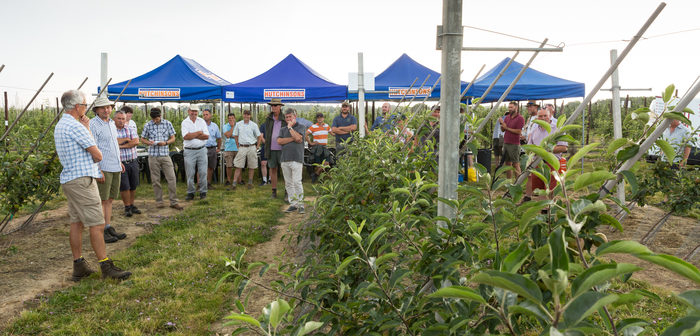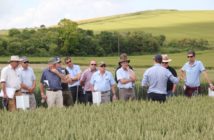A ground-breaking trial examining ways to improve the planting design and canopy management of apple orchards and “future-proof” them for robotic harvesting systems opened its doors to growers this summer.
The Hutchinsons Enhanced Light Interception Orchard System (HELIOS) was established last spring at two sites, in East Kent and on the Herefordshire/ Gloucestershire border, to examine how orchards can be cost-effectively re-designed and managed to capture more light, improve yields and allow new mechanical picking systems in future.
Several systems for growing Gala Galaxy clones on different rootstocks are being trialled over 10 years at both sites, with detailed yield and crop grading measurements due to be taken to help identify the most cost-effective options.
The planting configurations are inspired by research in New Zealand that suggests current orchard systems do not intercept as much sunlight as they could, so fall short of their theoretical maximum yield.
“In New Zealand, that theoretical maximum yield is around 150-160t/ha, but in the UK it’s probably nearer 120t/ha,” says Hutchinsons agronomist Rob Saunders, who manages the Kent trial hosted at Hoaden Court Farm near Canterbury.
Perhaps the most adventurous system being trialled is the “photovoltaic configuration” which features Gala Galaxy on M9 and the more vigorous M116 rootstock, angled on a 50-degree slope orientated east-west in a similar way to a ground-mounted solar PV array.
“Leaning a tree over at an angle like that does reduce vigour, but theoretically angled trees can capture approximately twice as much light as traditional planting in a north-south orientation,” says Mr Saunders. “We’re really pushing the limits of what might be possible and it’s quite a challenge to manage this growing system, although we’ll see what the yield effect is.”
One of the most promising systems so far at both HELIOS sites is the high density alternate leaning V spindle system using Gala Galaxy on M9 rootstock, planted at a tree spacing of 0.39m in the standard north-south orientation. Trees are pruned to create a planar canopy no more than 30cm deep to maximise light interception.
“In terms of yield potential, it’s definitely one of the most exciting, but it’s also the most expensive to establish given the sheer number of trees and need for a robust trellis system,” says Hutchinsons’s Nigel Kitney, who manages the western trial site near Newent.
This planting density at a 3.5m row spacing gives around 7,326 trees/ha, compared with nearer 2,000 to 3,000 trees/ha on many other systems, he notes. “It needs to deliver on yield to make up for these higher costs.”
At the other extreme is a low-cost trial of Gala Galaxy on M116 rootstock championed by Nick Dunn of F.P. Matthews, and chosen for its reduced canker levels, and resistance to drought, phytophthora and woolly aphid. Trees are orientated north-south at a 1.5m spacing, on 3.5m rows, to give a density of 1,904/ha.
“The concept is to see how cheaply it is possible to establish and grow an intensive dessert apple orchard,” says Mr Saunders. “We’ve placed small stakes every 10m and Deltex wire in between, but otherwise let the trees grow, with minimal support.”
Robot-ready orchards
Developing orchard designs that will be suitable for robotic mechanical harvesting systems is a key part of the Hutchinsons trials.
“In the medium term, the availability of labour for picking will become more difficult than it is now and present tree configurations aren’t really suitable for the robotic harvesting systems being developed,” says Mr Saunders.
“If we’re going to be picking apples with robots in future, it will be from a planar canopy and fruit wall no more than 30cm thick. Our trials here are designed to see what is, and isn’t achievable, with this sort of canopy design, so we can develop cost-effective, future-proof planting and management systems for our growers.”
Mr Kitney says the Guyot training system for growing Gala Galaxy on M116 rootstock looks to have good potential for producing a “robot-ready” crop that can maximise light interception, although he acknowledges it requires more work to prune and train the canopy in the early years. The system features a primary stem 15 degrees above horizontal and 4/5 vertical stems per tree, producing a target canopy width of 30cm.
At a tree spacing of 1.5m and the narrower 2.2m row width, this gives just over 3,000 trees/ha and 12,000-15,000 stems/ha, with excellent yield potential.
“We’re looking for 10-15kg per upright, so need quite a robust trellis system to support that weight,” notes Mr Saunders.
Varieties on trial
Several varieties that are new to the UK are also being trialled at the HELIOS sites to see how they fare under the contrasting soil types and climates of Kent and Herefordshire.
Varieties include:
- • Kitney Gala
- • Carolus Gala Big Bucks
- • Carolus Gala Devil
- • Fengapi
- • Carolus Finesse
- • Carolus Elshof Elstar Fortis
- • Carolus Asfari
- • Carolus Belgica
“A lot of Gala clones have been developed for hotter climates than the UK, so it will be interesting to see how they perform,” Mr Kitney says.
Another technique being tested is the use of Magnum trees of Gala Schnico on M9 rootstock, which have had one extra year in the nursery to produce bigger trees for planting in the spring and should give a higher yield in the first year.
“Magnum trees cost slightly more (0.5-1 euro) than standard two-year-old trees, but can out-yield them by 25%,” says Mr Kitney.
“Transporting larger trees does risk some damage, but so far they look good and should give a worthwhile pick in their first year. They may not be quite up to full crop in year two, but won’t be far off.”




